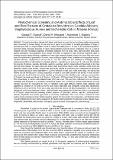| dc.description.abstract | Crotalaria brevidens (slenderleaf) leaves and shoots are used as food and have medicinal properties
when consumed by human beings. It also acts as an agent in promotion of suicidal germination of striga, a
parasitic plant that is a major problem weed for maize and millet growers. In view of its medicinal importance,
and there being increased tolerance of many microorganisms towards known antibiotics, there is a need to
establish the anti microbial properties of extracts obtained from its roots, stem, leaf and other body parts
against pathogenic microorganism. Even though this plant is reported to have immense medicinal value in
treating stomach related ailments, malaria and many other tropical diseases, before this study little was known
about the antimicrobial potentials of its roots, stem and leaves against three candidate microorganisms namely;
Candida albicans, staphylococcus aureus and E. coli. This study was thus initiated to investigate (1) the
antimicrobial effects of slenderleaf on Candida albicans, staphylococcus aureus and E. coli, and (2) establish
the presence of phenols, steroids, glycosides, saponins, quinones, tannins, terpenoids and flavonoids in its crude
leaf and root extracts. The plant roots and leaves used during these studies were collected, shade dried and
blended to obtain a fine powder. Ethanol was used as the solvent to extract the pure components by dissolving
25g of leaves and 6g of roots separately in 150ml of ethanol in each case. After seven days, the extract was
filtered and the filtrate put in a rotary evaporator to obtain a pure solid sample of the extract. A stock solution
was made with 3g of the leaf extract that resulted by dissolving in 40ml distilled water making a concentration
of 75mg/ml. the stock was diluted to 3.75mg/ml, 11.25mg/ml, 18.75mg/ml and 37.5mg/ml as 5%, 15%, 25% and
50% respectively. A control with distilled water (0%) was used. This was then replicated thrice to minimize
variability and arranged in a completely randomized design. The screening of antimicrobial activity of crude
extracts was done by measuring the zone of inhibition using agar diffusion method. Data obtained were
subjected to analysis of variance (ANOVA) and means separated and compared using least significance
difference (LSD) at (p<0.05). There was a clear zone observed around the discs impregnated in the extract and
transferred to the inoculated petri dishes. High inhibition was observed on Escherichia coli at a concentration
of 37.5mg/ml. phytochemical screening showed presence of flavonoids, tannins, saponins, anthraquinones,
phenols, terpenoids and cardiac glycosides as secondary metabolites. The crude extracts obtained in these
studies clearly indicated antimicrobial properties against the three tested microorganisms, and therefore there
is need to determine the main active components for studies that may lead to the discovery of new natural drugs. | en_US |

